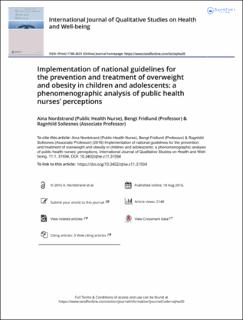Implementation of national guidelines for the prevention and treatment of overweight and obesity in children and adolescents: a phenomenographic analysis of public health nurses’ perceptions
Journal article

Åpne
Permanent lenke
https://hdl.handle.net/11250/3042728Utgivelsesdato
2016Metadata
Vis full innførselSamlinger
Originalversjon
Nordstrand, A., Fridlund, B. & Sollesnes, R. (2016). Implementation of national guidelines for the prevention and treatment of overweight and obesity in children and adolescents: a phenomenographic analysis of public health nurses’ perceptions. International journal of qualitative studies on health and well-being, 11(1), 31934. https://doi.org/10.3402/qhw.v11.31934Sammendrag
Objective
To explore and describe how public health nurses (PHNs) perceive the implementation of national guidelines for the prevention and treatment of overweight and obesity among children and adolescents in well-baby clinics and school health services.
Design, sample, and measurements
An explorative descriptive design was carried out through individual interviews with 18 PHNs and analysed according to the phenomenographic tradition.
Results
Four implementation strategies were described and assigned a metaphor: the structured PHN, pragmatic PHN, critical PHN, and the resigned PHN. Competence, patient receptiveness, internal consensus, interdisciplinary collaboration, resources, and organizational embedding were the determinants identified that most frequently affect implementation, and these determinants were distributed at different levels of the organization. The extent of facilitation seemed to determine which implementation strategy would be used.
Conclusions
How PHNs implemented the guidelines for overweight and obesity were affected by determinants at different organizational levels. Contextual facilitation of implementation seemed better in larger organizations, but factors such as leadership, drive, and experience compensated in smaller municipalities. The implementation of guidelines was hindered when the barriers exceeded the benefits.
